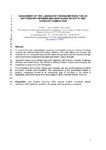Mostrar o rexistro simple do ítem
Assessment of Two Laboratory Design Methods for CIR Mixtures With Bitumen Emulsion Based on Static and Gyratory Compaction
| dc.contributor.author | Orosa, Pablo | |
| dc.contributor.author | Pasandín, A.R. | |
| dc.contributor.author | Pérez Pérez, Ignacio | |
| dc.date.accessioned | 2020-10-30T19:20:17Z | |
| dc.date.available | 2020-10-30T19:20:17Z | |
| dc.date.issued | 2020 | |
| dc.identifier.citation | Orosa Iglesias, Pablo & Rodríguez Pasandín, Ana Mª & Pérez Pérez, Ignacio. (2020). Assessment of two laboratory design methods for CIR mixtures with bitumen emulsion based on static and gyratory compaction. Construction and Building Materials. 265. 1-14. DOI: 10.1016/j.conbuildmat.2020.120667. | es_ES |
| dc.identifier.uri | http://hdl.handle.net/2183/26617 | |
| dc.description.abstract | [Abstract] To expand the body of knowledge regarding cold in-place recycled mixtures, this study presents two different laboratory design methods. The main differences between the methods are the compaction procedures (static and gyratory) and the required strength tests (unconfined compressive strength and indirect tensile strength). Specimens were manufactured using both methods, with different contents of bitumen emulsion and added water. The effects of adding Portland cement and increasing the compaction energy were also investigated. The compliance with strength criteria was reviewed, and the optimal bitumen emulsion and water contents were identified. The requirements of the specification based on gyratory compaction proved to be excessively high. A reduction of the values is suggested, and further research is encouraged to allow new benchmarks to be set. | es_ES |
| dc.description.sponsorship | The authors would like to acknowledge the funding of project BIA2016-80317-R/AEI/10.13039/501100011033 by the Spanish Ministry of Economy and Competitiveness with an associated pre-doctoral scholarship for research worker training (FPI) BES-2017-079633. The authors also would like to express their sincere gratitude to ARIAS INFRAESTRUCTURAS for the RAP and to CEPSA and ECOASFALT for the bitumen emulsion, which was generously donated for this study | |
| dc.language.iso | eng | es_ES |
| dc.publisher | Elsevier | es_ES |
| dc.relation | info:eu-repo/grantAgreement/AEI/Plan Estatal de Investigación Científica y Técnica y de Innovación 2013-2016/BIA2016-80317-R/ES/COMPORTAMIENTO MECANICO DE MEZCLAS ASFALTICAS RECICLADAS IN SITU CON EMULSION BITUMINOSA Y SU IMPACTO EN EL DIMENSIONAMIENTO DE FIRMES: INVESTIGACION DEL PERIODO DE MADURACION/ | |
| dc.relation | info:eu-repo/grantAgreement/AEI/Plan Estatal de Investigación Científica y Técnica y de Innovación 2017-2020/BES-2017-079633/ES/COMPORTAMIENTO MECANICO DE MEZCLAS ASFALTICAS RECICLADAS IN SITU CON EMULSION BITUMINOSA Y SU IMPACTO EN EL DIMENSIONAMIENTO DE FIRMES: INVESTIGACION DEL PERIODO DE MADURACION/ | |
| dc.relation.uri | https://doi.org/10.1016/j.conbuildmat.2020.120667 | es_ES |
| dc.subject | Cold in-place recycling (CIR) | es_ES |
| dc.subject | Asphalt mixture | es_ES |
| dc.subject | Reclaimed asphalt pavement (RAP) | es_ES |
| dc.subject | Bitumen emulsion | es_ES |
| dc.subject | Mix design method | es_ES |
| dc.subject | Gyratory compactor | es_ES |
| dc.title | Assessment of Two Laboratory Design Methods for CIR Mixtures With Bitumen Emulsion Based on Static and Gyratory Compaction | es_ES |
| dc.type | info:eu-repo/semantics/preprint | es_ES |
| dc.rights.access | info:eu-repo/semantics/openAccess | es_ES |
| UDC.journalTitle | Construction and Building Materials | es_ES |
| UDC.volume | 265 | es_ES |
Ficheiros no ítem
Este ítem aparece na(s) seguinte(s) colección(s)
-
CITEEC-CGM - Artigos [93]






